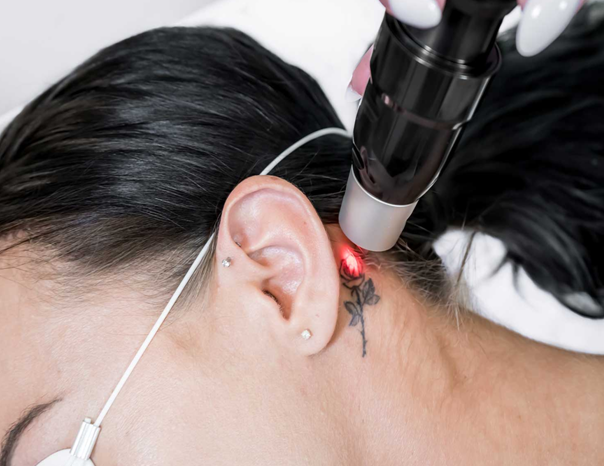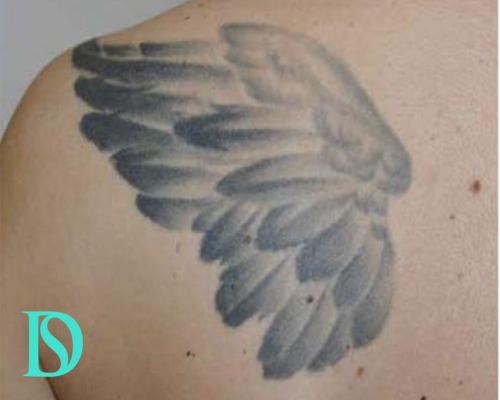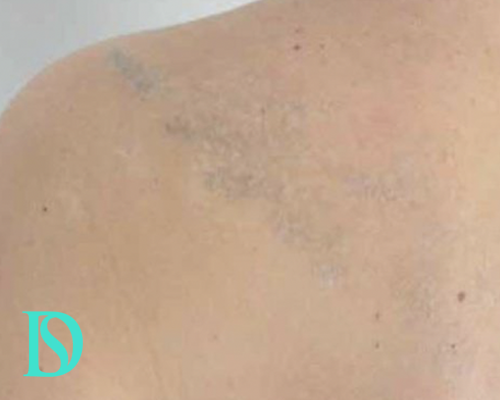Treatment at Derma Solution
Tattoo Removal

At Derma Solution we use the latest advanced Pico Laser technology methods for tattoo removal that offer several benefits over traditional methods. Pico lasers use ultra-short pulses of energy to break down tattoo ink into smaller particles, which can then be naturally eliminated by the body’s immune system. Here’s an overview of how PicoSure and similar pico laser systems work for tattoo removal, their benefits, and considerations:
How Pico Laser Tattoo Removal Works
Pico Pulse Technology:
- Ultra-Short Pulses: Pico lasers deliver energy in extremely short bursts, measured in picoseconds (trillionths of a second). These ultra-short pulses create a shockwave effect that shatters the tattoo ink particles into smaller fragments.
- Photoacoustic Effect: The rapid pulses generate a photoacoustic effect, which helps to break down the ink without causing significant damage to the surrounding skin.
Ink Fragmentation:
- Smaller Particles: By breaking the ink into smaller particles, pico lasers make it easier for the body’s immune system to remove these fragments more effectively.
- Enhanced Removal: This fragmentation process can lead to faster and more complete removal of the tattoo compared to traditional lasers.
Pico lasers, are often considered among the best options for tattoo removal due to several key advantages over traditional laser methods. Here’s why pico lasers are highly regarded:
1. Ultra-Short Pulse Duration
- Picosecond Pulses: Pico lasers deliver energy in picoseconds (trillionths of a second), which is significantly shorter than the nanosecond pulses used in traditional lasers. This ultra-short pulse duration creates a photoacoustic effect rather than just a photothermal effect.
- Shockwave Effect: The rapid pulses generate a shockwave that shatters tattoo ink particles into much smaller fragments compared to traditional lasers. This fragmentation facilitates more efficient removal of the ink.
2. Effective on Multiple Ink Colors
- Broad Spectrum: Pico lasers can target a wide range of ink colors, including challenging shades like green and blue. This is due to their ability to use different wavelengths or adjustable settings to address various ink pigments.
- Enhanced Ink Breakdown: The ability to break down ink particles more effectively means that pico lasers can remove tattoos with complex color compositions that may be difficult to treat with traditional lasers.
3. Reduced Risk of Scarring and Skin Damage
- Less Heat Generation: The ultra-short pulse duration reduces the amount of heat delivered to the skin, which minimizes the risk of thermal damage and scarring. This makes pico lasers safer for various skin types and tones.
- Less Inflammation: The less aggressive nature of pico lasers results in reduced inflammation and quicker recovery times.
4. Faster and Fewer Treatment Sessions
- Efficiency: Because pico lasers break down ink particles more thoroughly, patients often see significant improvement in fewer sessions compared to traditional laser treatments. This leads to a more efficient process overall.
- Reduced Treatment Time: The improved effectiveness means that larger and more complex tattoos can be addressed more quickly.
5. Minimal Discomfort
- Comfort: Many patients report that pico laser treatments are less painful than traditional laser methods. This can be attributed to the reduced heat and quicker pulse duration, which results in less overall discomfort during the procedure.
6. Better Results in Removing Stubborn Tattoos
- Persistent Tattoos: Pico lasers are particularly effective for removing tattoos that have been previously treated with other methods without complete success. The enhanced ink fragmentation allows for a more thorough removal process.
7. Advanced Technology
- Innovation: Pico lasers represent the latest advancement in tattoo removal technology. They incorporate sophisticated techniques that improve treatment outcomes and patient experience, reflecting ongoing progress in cosmetic laser technology.
Comparison with Traditional Lasers
- Nanosecond Lasers: Traditional lasers, such as those using nanosecond pulses, rely on a photothermal effect to heat and destroy ink particles. While effective, they often require more sessions and may result in more side effects like pigmentation changes or scarring.
- Q-Switched Lasers: Older Q-switched lasers also use nanosecond pulses and have been effective, but they generally do not offer the same level of efficiency and safety as pico lasers. They may require more treatments and have higher risks of side effects.
Pico lasers are considered among the best for tattoo removal due to their ultra-short pulse technology, which allows for effective ink fragmentation, reduced risk of scarring, and the ability to treat a broad spectrum of ink colors. The advancements in pico laser technology provide a more efficient, safer, and comfortable option for individuals seeking to remove unwanted tattoos.
- Body:
- Large Tattoos: Pico lasers are effective for removing large tattoos, including those on the back, arms, and legs.
- Sensitive Areas: The technology is also suitable for tattoos in sensitive areas where traditional methods might cause more discomfort.
Face:
- Facial Tattoos: Pico lasers can be used to remove tattoos on the face, including those on the eyebrows or lips, with minimal risk of scarring.
- Sessions:
- Frequency: Typically, multiple sessions (6-10) are required for complete tattoo removal. The exact number of sessions depends on factors like tattoo size, ink color, and depth.
- Intervals: Sessions are usually spaced 6-8 weeks apart to allow the skin to heal and the body to process the ink fragments.
Pre-Treatment Preparation:
- Consultation: A consultation with a qualified practitioner is essential to assess the tattoo, discuss expectations, and create a personalized treatment plan.
- Skin Care: Avoid sun exposure and tanning before treatment to prevent complications and ensure optimal results.
Post-Treatment Care:
- Sun Protection: Use sunscreen to protect the treated area from UV exposure and prevent pigmentation changes.
- Moisturization: Keep the skin hydrated and follow any aftercare instructions provided by the practitioner.
Summary of Your Treatment
Procedure Time:
Various
Back to Work:
Immediate
Anaesthetic:
Topical
Sensitivity Period:
1 – 7 days
Duration of results:
permenant
Risks and Complications:
Redness, swelling, blistering, pigment changes
Book Now:
Procedure Time:
Various
Back to Work:
Immediate
Anaesthetic:
Topical
Full Recovery:
(Talked about removing this)
Sensitivity Period:
24 hours estimated
Duration of results:
Long Term Results
Risks and Complications:
Redness & Irritation
Book Now:


Price GuaranteeOn All Treatment
Derma Solution offers a price guarantee on all of our treatment ranges. If you are able to find a treatment that we offer cheaper anywhere in Copenhagen we will match the price.
Tattoo Removal
Treatment Prices
-
Extra Small (1-3 cm) DKK 1.990
-
Small (4-8 cm) DKK 2.750
-
Medium (9-15 cm) DKK 3.490
-
Large (16-20 cm) DKK 4.490
-
Extra Large (21-30 cm) DKK 5.750
-
Consultation DKK Free
Tattoo Removal
Frequently Asked Questions
Unfortunately, no method of tattoo removal is completely pain-free. Laser tattoo removal has been likened to the feeling of having a rubber band repeatedly snapped against the skin. Others describe it as a rapid succession of sharp pinpricks, or a warm, prickly sensation. Because a lot of energy is needed in order for the laser to break up the ink particles under your skin, this treatment can be uncomfortable for some people. Your skin will also need 6 – 12 weeks to recover between treatments.
Lasers remove tattoos by penetrating the skin and breaking up the ink into tiny particles. After several treatments (with regular intervals between sessions), the body breaks down and removes the pigment in the tattoo, causing it to fade.
Laser tattoo removal may not be suitable for you if you have a dark skin tone; this is due to the potential of the treatment leaving a ‘ghosting’ effect, where the skin is lighter than the surrounding area. Our practitioners can assess your tattoo and determine which solution is most appropriate in a free consultation. In some cases, the most appropriate form of removal for a tattoo could be excision. This involves having the tattoo surgically removed using a scalpel. Although more invasive, it can sometimes be the most effective solution and may also be quicker.
A tattoo can be faded adequately to re-cover after a couple of sessions. Your practitioner will be able to advise how many sessions you are likely to need during your consultation.
The ink particles of the tattoo will have been injected deep into the dermis (the second layer of skin). In order to reverse this process effectively, the pigment within the skin needs to be broken down using targeted lasers. Don’t be fooled into believing that if you have a change of heart shortly after getting your tattoo it can be easily removed.
Yes, it’s very safe. The laser energy is selectively absorbed by the tattoo ink only, meaning that surrounding tissues are not affected and there is no lasting damage to the skin.
Other tattoo removal methods do not involve lasers. We do not recommend the following methods of tattoo removal because they can cause scarring and have a high risk of infection.
Tattoo removal creams – these work by dissolving the tattoo using chemicals such as hydroquinone, kojic acid, alpha arbutin and TCA. They cannot completely remove a tattoo, but may reduce its appearance in some cases. Dermabrasion tattoo removal – this involves using an abrasive device to blast the surface of the skin in order to break down the tattoo and remove the top layers of skin. A local anaesthetic is usually administered as this is a painful method of removal. Salabrasion – this works in a similar way to dermabrasion but involves applying water and salt in addition to an abrasive device in order to lift and remove layers of skin. Acid tattoo removal – some people are now using acids, similar to those used in chemical skin peels, to burn away layers of the skin in order to get rid of their tattoos. Many health professionals strongly advise against this method.
Important information
This treatment must be performed by a trained aesthetician. Our Body Specialists are trained aestheticians that specialise in aesthetic, non-surgical, non- invasive body transformation procedures.



